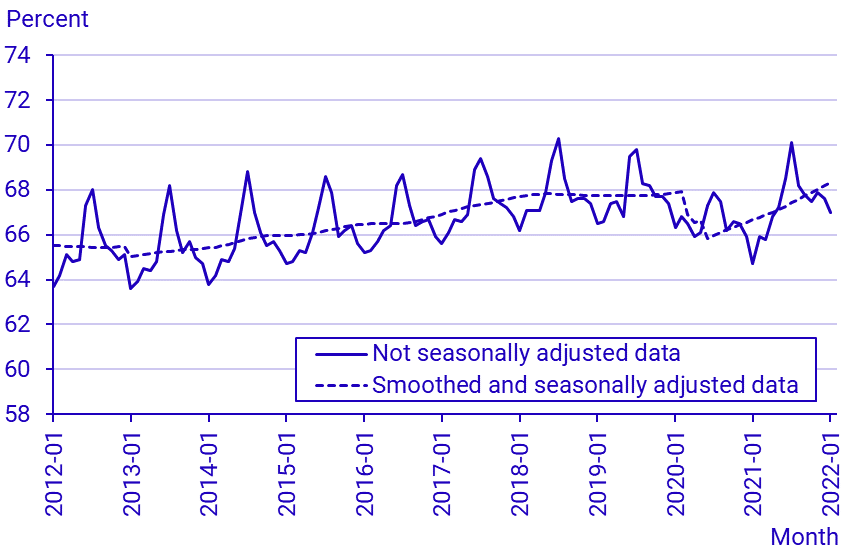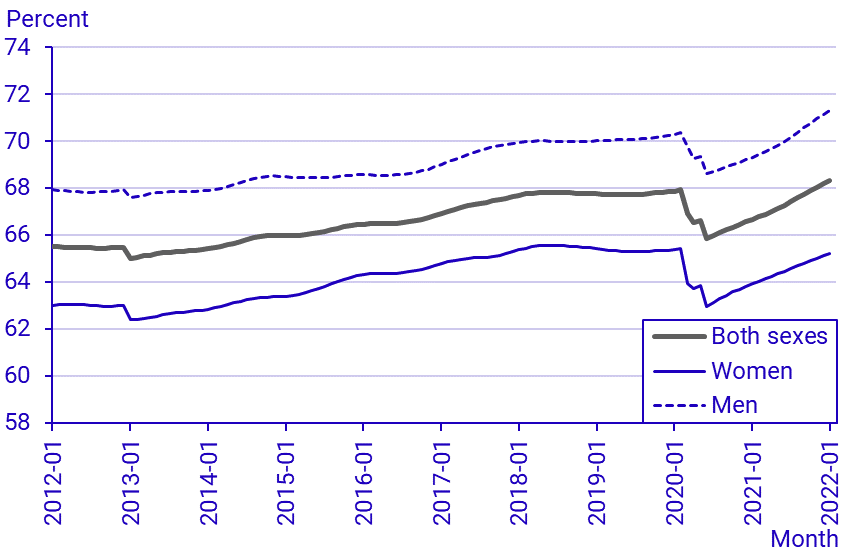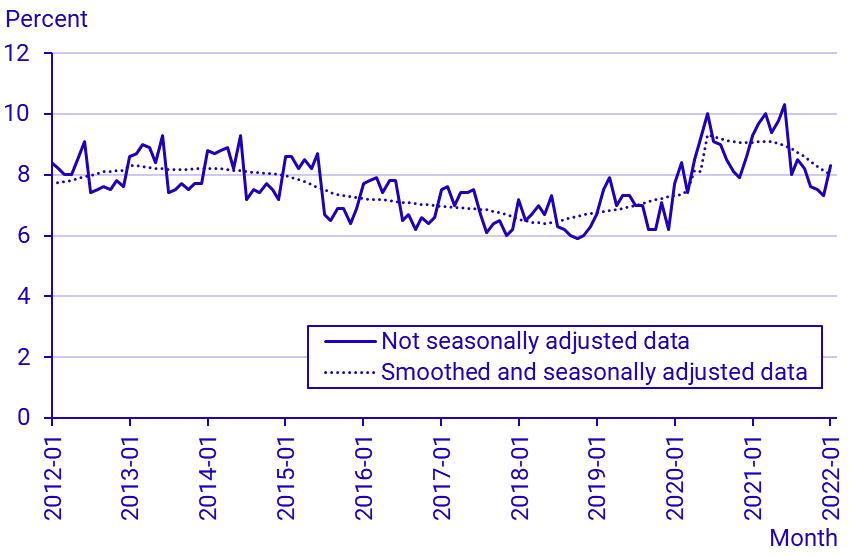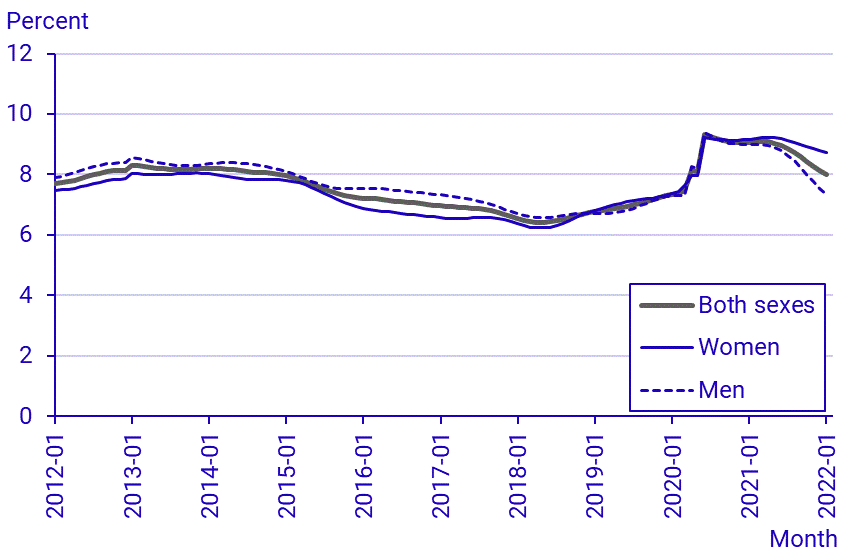Labour Force Surveys (LFS), January 2022
Employment continues to increase
Statistical news from Statistics Sweden 2022-02-24 8.00
In January 2022, there were 5 030 000 employed persons, not seasonally adjusted. This is an increase of 167 000 persons compared to January 2021. The number of unemployed people amounted to 458 000. The unemployment rate was 8.3 percent, a decrease of 1.0 percentage points. The average number of hours worked per week amounted to 142.2 million. In calendar-adjusted figures, this corresponds to a decrease of 3.3 percent. Smoothed and seasonally adjusted data indicates an increase in the employment rate and a decrease in the unemployment rate. The unemployment rate was 8.0 percent.
Since 1 January 2021, the Swedish LFS is in compliance with the new EU framework regulation on social statistics (Regulation (EU) 2019/1700).
The changes have caused breaks in the LFS time series. To make the series comparable in time, a selection of series has been linked backwards to 2005 according to the new practise. Those series are published at the same time as the LFS January. Later this year further series will be published.
The labour force
In January 2022, there were 5 488 000 persons aged 15–74 in the labour force, not seasonally adjusted. This is an increase of 127 000 persons compared to the corresponding month a year ago. The number of women in the labour force was 2 611 000, an increase of 80 000. The number of men was 2 877 000. The relative labour force participation rate was 73,1, an increase of 1.8 percentage points. Among women, it was 70.6, an increase of 2.1 percentage points and among men, it was 75.5, an increase of 1.5 percentage points.
Seasonally adjusted and smoothed data shows an increase in both the number and share of persons in the labour force compared with nearby months. The number of persons in the labour force amounted to 5 579 000 persons, corresponding to a labour force participation rate of 74.3.
Employment
In January 2022, there were 5 030 000 employed persons aged 15─74, not seasonally adjusted, which is an increase of 167 000 compared to the corresponding month a year ago. There were 2 369 000 employed women, an increase of 70 000, and 2 661 000 employed men, an increase of 97 000. The employment rate increased by 2.3 percentage points to 67.0 percent. Among women, the employment rate was 64.1 percent, an increase of 1.9 percentage points. Among men, it was 69.9 percent, an increase of 2.9 percentage points.
Smoothed and seasonally adjusted data indicates an increase in both the number and share of employed persons compared with recent months. There were 5 132 000 employed persons, corresponding to an employment rate of 68.3 percent.
There were 817 000 people absent for the whole week in January 2022, an increase of 243 000 compared to the corresponding month a year ago. Compared with previous months, smoothed and seasonally adjusted data shows an increase in the number of people absent for the whole week. The number amounted to 826 000.
Employees
In January 2022, there were 4 536 000 employees, not seasonally adjusted. This is an increase of 168 000 compared with the corresponding month last year. Among women, there were 2 208 000 employees. Among men, there were 2 328 000 employees, an increase of 134 000.
There were 3 906 000 permanent employees in the same period, an increase of 125 000. Among women, there were 1 846 000 permanent employees. The number of permanent employees among men was 2 060 000, an increase of 118 000.
There were 630 000 temporary employees. Among them, 362 000 were women and 268 000 were men.
Compared with previous months, smoothed and seasonally adjusted data shows an increase in the number of employees and in permanent employees.
Hours worked
The average number of hours worked in January 2022 amounted to 142.2 million per week, not seasonally adjusted. In calendar-adjusted figures, this corresponds to a decrease of 3.3 percent compared with the corresponding month a year ago.
Seasonally adjusted and smoothed data shows a decrease in the average number of hours worked per week compared to nearby months. The number amounted to 151.0 million.
Unemployment
In January 2022, there were 458 000 unemployed persons aged 15–74 years, not seasonally adjusted. This corresponds to an unemployment rate of 8.3 percent, a decrease of 1.0 percentage points compared to the corresponding month one year ago. Among the unemployed persons, there were 243 000 unemployed women. The number of unemployed men decreased by 51 000 and amounted to 215 000. Among women, the unemployment rate was 9.3 percent. Among men, the unemployment rate was 7.5, a decrease of 1.9 percentage points. Among those who were unemployed, 154 000 had been unemployed for more than six months.
There were 131 000 unemployed young people aged 15–24 years, corresponding to an unemployment rate of 22.5 percent. Among unemployed young people, 84 000 persons were full-time students.
Among persons aged 15–74 years, seasonally adjusted and smoothed data shows a decrease in both the number and share of unemployed persons compared to nearby months. In January 2022 there were 446 000 unemployed persons, which corresponds to an unemployment rate of 8.0 percent.
Among young people aged 15–24, seasonally adjusted and smoothed data shows a decrease in both the number and share of unemployed persons compared to nearby months. The number of unemployed young people amounted to 144 000, corresponding to an unemployment rate of 23.0 percent.
Impact of COVID-19 on the labour market
In view of the ongoing coronavirus (COVID-19) pandemic, additional questions concerning the impact of COVID-19 have been added to the LFS. Based on these questions, 199 000 employed persons aged 15–74 years stated that they were absent during the whole reference week related to COVID-19. This means that among persons who were absent during the entire reference week, 24.8 percent were absent due to COVID-19. This proportion was 23.8 percent among women and 25.8 percent among men.
Among employees aged 15–74 years who were absent during the entire reference week, 24.3 percent, which corresponds to 173 000 persons, stated that their absence was linked to COVID-19. This proportion was 22.9 percent among women and 26.0 percent among men. Furthermore, among employees who were absent during part of the week, 250 000 persons, that is, 22.7 percent, stated that their absence was linked to COVID-19. Among self-employed persons and unpaid family members aged 15–74 years, 30.2 percent felt that they had less work due to the coronavirus pandemic, while 17.0 percent felt that they had more work.
To be classified as unemployed in the LFS, a person must be without a job, must be able to start work and must have sought work. This means that people who are without a job, but who have not been seeking work or are not available to start work are not classified as being unemployed, but are, instead, not in the labour force. In January 2022, 2 017 000 persons aged 15–74 years were outside the labour force. Among these people, 39 000 stated that they would have been available to work but had not looked for work due to COVID-19.




Next publishing will be
2022-03-18 08:00.
Feel free to use the facts from this statistical news but remember to state Source: Statistics Sweden.
